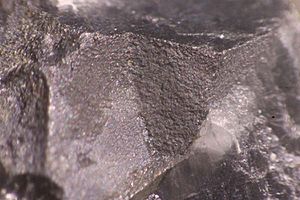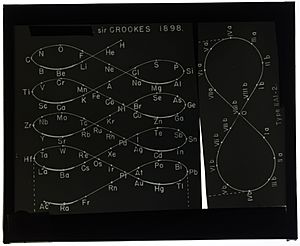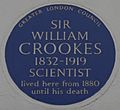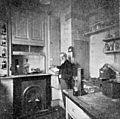William Crookes facts for kids
Quick facts for kids
William Crookes
|
|
|---|---|
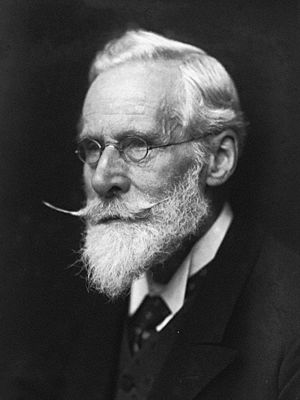
Sir William Crookes in 1906
|
|
| Born | 17 June 1832 London, England, UK
|
| Died | 4 April 1919 (aged 86) London, England, UK
|
| Nationality | English |
| Citizenship | British |
| Alma mater | Royal College of Chemistry Imperial College London |
| Known for | Plasma Scintillator Spinthariscope Thallium Gemstone irradiation Crookes tube Crookes radiometer |
| Awards | Royal Medal (1875) Davy Medal (1888) Albert Medal (1899) Copley Medal (1904) Elliott Cresson Medal (1912) |
| Scientific career | |
| Fields | Physical chemistry |
| Influenced | J. K. F. Zöllner |
Sir William Crookes (born June 17, 1832 – died April 4, 1919) was an important British scientist. He was both a chemist and a physicist. He studied at the Royal College of Chemistry in London. This college is now part of Imperial College London.
Crookes was a pioneer in working with vacuum tubes. He invented the Crookes tube in 1875. This invention was a big step forward in science. It helped change how we understand chemistry and physics. He also discovered the element thallium in 1861. He was the first to describe the spectrum of helium found on Earth. Crookes also invented the Crookes radiometer and special sunglasses. These sunglasses could block 100% of harmful ultraviolet light. For a time, he was also very interested in spiritualism.
Contents
About William Crookes
William Crookes had a very long and active scientific career. It lasted for 67 years. People thought he was very hardworking and smart. His science experiments were known for being very original. He was called a "superb experimentalist" because he was so good at doing experiments.
Crookes was interested in many things. These included pure science, practical problems, and even psychic research. Because of his wide interests, he became a well-known person. He also earned a lot of money and received many awards.
His Early Life
William Crookes was born in London in 1832. He was the oldest of eight children who lived to be adults. His father, Joseph Crookes, was a rich tailor and real estate investor. His mother was Mary Scott. William's grandfather and great-grandfather were also tailors.
William's father had other sons from a first marriage. These sons took over the family tailoring business. This meant William was free to choose his own path. In 1848, when he was 16, Crookes went to the Royal College of Chemistry. He studied organic chemistry there. He lived with his parents about three miles from the college.
For his first year, Crookes paid £25 for tuition. He also had to buy his own equipment and some chemicals. After his first year, he won a scholarship. This scholarship paid for his second year of studies. After his second year, Crookes became an assistant to August Wilhelm von Hofmann. He helped with lab demonstrations and research. He stayed in this job until 1854.
Crookes respected Hofmann, but he was not as interested in organic chemistry. One of his students was Reverend John Barlow. Barlow was the Secretary of the Royal Institution. Through Barlow, Crookes met famous scientists like George Gabriel Stokes and Michael Faraday. These friends helped Crookes become more interested in optical physics. By 1851, his father even built him a laboratory at home.
Crookes started his own research not in organic chemistry, but in new compounds of selenium. These were the topic of his first published papers in 1851. In 1854, he worked at the Radcliffe Observatory in Oxford. He used a new method called wax paper photography. This helped machines record weather information continuously. In 1855, he became a chemistry teacher at the University of Chester.
In 1856, Crookes married Ellen Humphrey. Because teachers at Chester had to be single, he had to leave his job. William's father gave the couple a house in London. Ellen's mother lived with them for almost 40 years. William and Ellen were a loving couple. They had six sons and three daughters. Their first child, Alice, worked as her father's assistant for many years.
After getting married, Crookes supported his family by working as a photographic chemist. In 1859, he started a science magazine called Chemical News. He edited it for many years. He also worked with the Quarterly Journal of Science and other photography journals.
His Middle Years and Discoveries
Crookes was very good at doing experiments. He was very excited about spectral analysis. This method was developed by Bunsen and Kirchhoff.
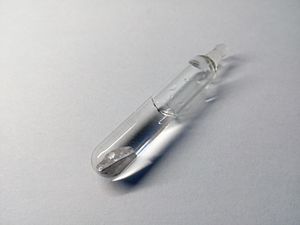
His first big discovery was the element thallium. He found it using flame spectroscopy. Crookes saw a new element with a bright green line in its spectrum. He named it thallium, which comes from a Greek word meaning "a green shoot." He published his findings in 1861.
Another scientist, Claude Auguste Lamy, also discovered thallium independently. Both Crookes and Lamy isolated the element in 1862.
Crookes became a member of the Royal Society in 1863. He wrote an important book called Select Methods in Chemical Analysis in 1871.
In 1866, a rare mineral was found and named crookesite. It was named after Sir William Crookes. This mineral contains copper, thallium, and silver.
Crookes also developed the Crookes tube. He used it to study cathode rays. He wrote many papers on spectroscopy. He also researched many other small topics. He studied how electricity moves through gases at low pressure. He found that the negative electrode (cathode) seemed to send out rays. These were called "cathode rays." We now know these are streams of free electrons.
Crookes was one of the first scientists to use vacuum tubes to study physical things. He was also one of the first to study what we now call plasma. He identified plasma as the fourth state of matter in 1879. He also invented one of the first tools to study radioactivity. This tool was called the spinthariscope.
Crookes studied the properties of cathode rays. He showed that they travel in straight lines. They also cause things to glow (fluorescence) when they hit them. Their impact can also create a lot of heat. He thought he had found a fourth state of matter, which he called "radiant matter." However, his ideas about "radiant matter" were later changed. He thought the rays were made of streams of regular molecules. Later, Sir J. J. Thomson showed that cathode rays were made of tiny negative electrons. Still, Crookes's experiments were very important. They led to discoveries that changed all of chemistry and physics.
Crookes became interested in the vacuum balance while studying thallium. He soon discovered how the Crookes radiometer works. This device has vanes (like small blades) that spin when light hits them. One side of each vane is black, and the other is shiny. Crookes did not fully explain why this happened.
After 1880, Crookes lived in a fancy area of London. His home included a large family and many servants. All his later work was done there. He had "the finest private laboratory in Britain." It took up a whole floor of his house. It had three connected rooms for chemistry, physics, and building things, plus a library. Crookes could buy this house and build the lab because he earned money from a company and his inventions.
By 1880, Crookes had a full-time science assistant. His daughter Alice also helped him. She was good at separating rare earth elements and understanding spectra.
His daily routine was to handle business in the morning. In the afternoon, he would do more business or go to science meetings. He ate dinner at 7 PM. Then he worked in his library from 8 to 9 PM. After that, he worked in his laboratory until after midnight. From his home, Crookes could easily get to his magazine office and other science clubs.
In 1884, Crookes' father died. His daughter Florence also died that same week from scarlet fever. His father's money was left in a trust. It was divided among his three sons, including William. This made Crookes very wealthy.
In 1886, Crookes became a member of the American Philosophical Society.
Later Years and Achievements
In 1894, two scientists, John William Strutt, 3rd Baron Rayleigh and William Ramsay, found a new gas in the air. In 1895, they told the Royal Society about this new gas, called argon. William Crookes was asked to look at a sample of argon. He reported that argon showed two different spectra. In this way, Crookes found the first known sample of helium on Earth. He also showed it matched helium seen in the sun. The discovery of argon and helium led to finding the noble gases. It also helped reorganize the periodic system of elements. Crookes himself suggested a new design for the Periodic table in 1898.
Crookes was made a knight in 1897.
In 1898, Crookes became president of the British Association for the Advancement of Science. In his speech, he talked about a big problem that was coming. He said that people who eat wheat would start running out of food in the 1930s. He explained that this was because there wasn't enough nitrogen fertilizer from natural sources. Crookes asked chemists to find new ways to make fertilizer from the huge amount of nitrogen in the air. His ideas about the coming food shortage were widely shared. They even became a popular book. Scientists like Kristian Birkeland, Fritz Haber, and Carl Bosch worked on this problem. Their work led to the Haber–Bosch process, which is used today to make nitrogen fertilizer.
In 1903, Crookes started studying radioactivity. This was a newly discovered phenomenon. He managed to separate a substance called uranium-X from uranium. (We now know this is protactinium.) Crookes saw that the separated substance slowly decayed. He also saw that new uranium-X was being made in the original uranium. Around the same time, he noticed something else important. When tiny particles from radioactive substances hit zinc sulfide, each hit caused a tiny flash of light. This observation became a very useful way to detect radioactivity.
In 1913, Crookes created a special lens that blocked ultraviolet light. It was made from glass with cerium in it. These lenses were a side product of his research. He was trying to find a glass that would protect glass workers from eye problems like cataracts. Crookes tested over 300 different glass mixtures. The best ones were called Crookes Glass 246. Other well-known Crookes lenses, like A, A1, B, and B2, block all ultraviolet light below 350 nanometers. They also darken regular light.
Interest in Spiritualism
Crookes became interested in spiritualism in the late 1860s. He was most involved around 1874–1875. Some people think his interest in detecting unseen forces in science led him to study the occult.
He may have been influenced by the death of his younger brother Philip in 1867. Philip died from yellow fever. In 1867, Crookes went to a séance (a meeting to try to talk to spirits). He hoped to get in touch with his brother.
Between 1871 and 1874, Crookes studied mediums like Kate Fox, Florence Cook, and Daniel Dunglas Home. After his studies, he believed that these mediums could produce real paranormal phenomena. He thought they could communicate with spirits.
Some people later pointed out that Crookes had poor eyesight. This might have affected what he thought he saw. One scientist, William Ramsay, said that Crookes was "so shortsighted that... he cannot be trusted in what he tells you he has seen."
Regarding Florence Cook, some historians believe that the "spirit" named "Katie King" was sometimes Cook herself or someone helping her. Even though Crookes had a great scientific reputation, he did not realize that a person was pretending to be a ghost. Cook had learned many tricks for séances, which helped her trick Crookes.
In 1875, a medium named Anna Eva Fay also managed to trick Crookes. She made him believe she had real psychic powers. Fay later admitted she used tricks. Magician Harry Houdini also suggested that Crookes had been tricked. Some scientists believe Crookes's experiments were not controlled well enough. They think his strong desire to believe made him overlook the tricks.
In 1916, a man named William Hope tricked Crookes with a fake spirit photograph of his wife. Another scientist, Oliver Lodge, saw clear signs that the picture was faked. It was copied from a wedding anniversary photo. However, Crookes was a strong believer in spiritualism and claimed the photo was real proof of spirit photography.
Some researchers have suggested that Crookes might have been too embarrassed to admit he was tricked. Others wondered if he worked with the mediums. They concluded that all of Hope's feats were just magic tricks.
Crookes joined the Society for Psychical Research. He became its president in the 1890s. He also joined the Theosophical Society and The Ghost Club. He was president of The Ghost Club from 1907 to 1912. In 1890, he joined a group called the Hermetic Order of the Golden Dawn.
Images for kids
See also
 In Spanish: William Crookes para niños
In Spanish: William Crookes para niños



